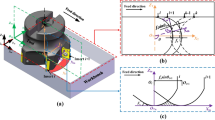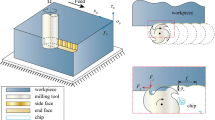Abstract
In face milling processes, the surface roughness of the machined part reflects the cutting performance of face milling cutter. Surface roughness depends on different factors including feed direction, axial and radial run-out errors, and cutting tool geometry. In this paper, an algorithm considering the effects of static and dynamic factors on surface roughness for predicting the surface roughness is proposed. This work is focusing on straight-edged square insert. The dynamic characteristics of the milling process are also introduced. An electronic impact hammer is used to identify the dynamic parameters of the cutting system. Milling experiments are conducted to validate the prediction model. Results show that the prediction model can estimate the surface roughness of the machined parts after face milling. This paper provides an in-depth understanding of the relationship between machined surface roughness and process conditions especially for axial and radial run-out errors induced by static deformation and Z-axial relative displacement induced by forced vibration. The outcome of this research will lead to methodologies for cost-effective monitoring and surface roughness control.
Similar content being viewed by others
References
Wu WP (2008) Investigation of the effects of face-milling parameters of ultra-large-scale plane on milling quality. Int J Adv Manuf Technol 37:241–249
Cui X, Zhao J (2014) Cutting performance of coated carbide tools in high-speed face milling of AISI H13 hardened steel. Int J Adv Manuf Technol 71:1811–1824
Mansour A, Abdalla H (2002) Surface roughness model for end milling: a semi-free cutting carbon casehardening steel (EN32) in dry condition. J Mater Process Technol 124(1–2):183–191
Wang MY, Chang HY (2004) Experimental study of surface roughness in slot end milling Al2014-T6. Int J Mach Tool Manuf 44(1):51–57
Twardowski P, Wojciechowski S, Wieczorowski M, Mathia T (2011) Surface roughness analysis of hardened steel after high-speed milling. Scanning 33:386–395
Benardos PG, Vosniakos GC (2003) Predicting surface roughness in machining: a review. Int J Mach Tool Manuf 43:833–844
Ehmann KF, Hong MS (1994) A generalized model of the surface generation process in metal cutting. CIRP Ann Manuf Techn 43:483–486
Kim BH, Chu CN (1999) Texture prediction of milled surfaces using texture superposition method. Comput Aided Des 31:485–494
Baptista R, Antune Simoes JF (2000) Three and five axis milling of sculptured surfaces. J Mater Process Technol 103:398–403
Tian X, Zhao J, Zhao J, Gong Z, Dong Y (2013) Effect of cutting speed on cutting forces and wear mechanisms in high-speed face milling of Inconel 718 with Sialon ceramic tools. Int J Adv Manuf Technol 69:2669–2678
Sai K, Bouzid W (2005) Roughness modeling in up-face milling. Int J Adv Manuf Technol 26:324–329
Franco P, Estrems M, Faura F (2004) Influence of radial and axial runouts on surface roughness in face milling with round insert cutting tools. Int J Mach Tool Manuf 44:1555–1565
Dae KB, Tae JK, Hee SK (1997) A dynamic surface roughness model for face milling. Prec Eng 20:171–178
Lee KY, Kang MC, Jeong YH, Lee DW, Kim JS (2001) Simulation of surface roughness and profile in high-speed end milling. J Mater Process Technol 113:410–415
Cui X, Guo J, Zhao J, Yan Y (2014) Chip temperature and its effects on chip morphology, cutting forces, and surface roughness in high-speed face milling of hardened steel. Int J Adv Manuf Technol 77:2209–2219. doi:10.1007/s00170-014-6635-4
Lela B, Bajic D, Jozid S (2008) Regression analysis, support vector machines, and Bayesian neural network approaches to modeling surface roughness in face milling. Int J Adv Manuf Technol 42:1082–1088
Eysion A, Liu QZ (2011) Machined surface error analysis—a face milling approach. J Adv Manuf Syst 10:293–307
Maciej G, Andres B, Guillem Q (2012) Improvement of surface roughness models for face milling operations through dimensionality reduction. Integr Comput Aid Eng 19:179–197
Author information
Authors and Affiliations
Corresponding author
Rights and permissions
About this article
Cite this article
Zhenyu, S., Luning, L. & Zhanqiang, L. Influence of dynamic effects on surface roughness for face milling process. Int J Adv Manuf Technol 80, 1823–1831 (2015). https://doi.org/10.1007/s00170-015-7127-x
Received:
Accepted:
Published:
Issue Date:
DOI: https://doi.org/10.1007/s00170-015-7127-x




